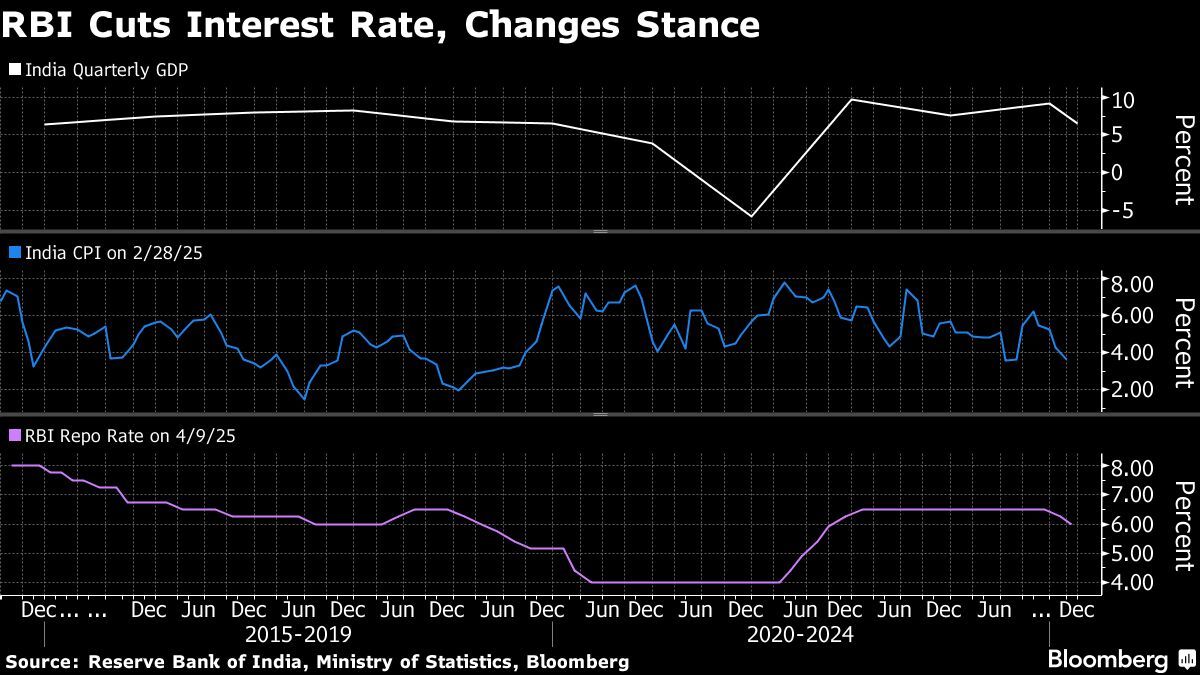
(April 9): India’s central bank cut interest rates, as expected, and signalled more easing to come as it seeks to bolster Asia’s third-largest economy in the face of damaging US tariffs.
The Reserve Bank of India’s (RBI) six-member Monetary Policy Committee (MPC), headed by governor Sanjay Malhotra, voted unanimously to lower the repurchase rate by 25 basis point to 6%, in line with a Bloomberg survey.
All the members of the MPC also decided to shift its policy stance to “accommodative” from “neutral”, which means it is considering more rate cuts in coming months.
“Going forward, absent any shocks, the MPC is considering only two options — the status quo or rate cuts,” Malhotra said in a televised speech on Wednesday from Mumbai. “The domestic growth-inflation trajectory demands monetary policy to be growth-supportive, while being watchful on the inflation front.”
Indian bonds erased losses as the central bank changed its stance, and said it will ensure sufficient liquidity in the banking system. The sovereign 10-year bond yield was down two basis points to 6.46%, while shorter-duration bonds fell even more sharply, with the five-year yield down six basis points. The rupee is at a three-week low, falling 0.4%.
The RBI’s decision comes less than an hour after Washington’s reciprocal tariffs kicked in, dealing a thunderous blow to the world economy. At a post-policy press conference, Malhotra acknowledged the impact of disruptions in global trade on growth.
The tariffs are certainly a “growth dampener”, the governor told reporters, but added that India is “better placed than some of the other countries”, which are more dependent on exports.
By cutting rates for two straight policy meetings, Malhotra has signalled that the central bank intends to support a slowing economy. The South Asian nation expanded 6.5% in the past fiscal year, its weakest pace since the pandemic, and economists predict a 20 to 40 basis point growth drag due to tariffs this year.
The central bank chief also lowered growth outlook for the year that started on April 1 to 6.5% from 6.7% earlier. He pegged inflation at 4% compared to a previous forecast of 4.2%.
“The combination of downgrades to its gross domestic product growth and inflation projections and the change in stance to accommodative all reinforce that this is a dovish cut,” said Sonal Varma, an economist at Nomura Holding Inc.
Economists said deeper cuts are on the cards to further shield the South Asian economy. “We see scope for additional 75 to 100 basis points of rate cuts in the year ahead depending on the scale of global slowdown,” said Upasna Bhardwaj, an economist at Kotak Mahindra Bank Ltd. Varma also expects the easing cycle to continue with quarter-point cuts each in June and August policy meetings.
At the press briefing, Malhotra declined to talk about how low the rates can go, or other future policy decisions. “So much of uncertainty, you really can’t take a bet on what’s going to happen in the near or medium term,” he said. “It’s all about sentiment.”
India’s below-target inflation last month and lower oil prices are giving the RBI reason to stay with the looser policy settings.
“The MPC noted that inflation is currently below the target, supported by a sharp fall in food inflation,” the governor said. “There is now a greater confidence of a durable alignment of headline inflation with the target of 4% over a 12-month horizon.”
Sufficient liquidity
Since taking office in December, Malhotra has pivoted to a more growth-friendly approach than his predecessor, Shaktikanta Das. He cut rates for the first time in five years in his debut policy meeting in February, and has injected more than US$80 billion (RM359.42 billion) into the banking system in the last two months. On Wednesday, Malhotra said the RBI will continue to ensure there is ample money in the system.
“We will provide sufficient liquidity to the system so that this transmission of policy rate into interest rate happens quickly,” Malhotra told reporters, adding that the RBI aims to maintain surplus of about 1% of net deposits.
On the rupee, Malhotra said the central bank will intervene in the currency market to curb excessive volatility. If intervention is required, “we will not be found wanting”, the governor said.
Uploaded by Tham Yek Lee
- Taiwan's TSMC warns of limits of ability to keep its AI chips from China
- Three banks underwrite the entire retail portion of Main Market-bound Paradigm REIT
- US tariffs on Chinese gloves not enough to lift sector outlook, says AmInvest
- Déjà vu: Stock market crashes in the last 40 years
- West Coast Expressway operator receives government consent for RM1.15b financing from Bank Pembangunan

